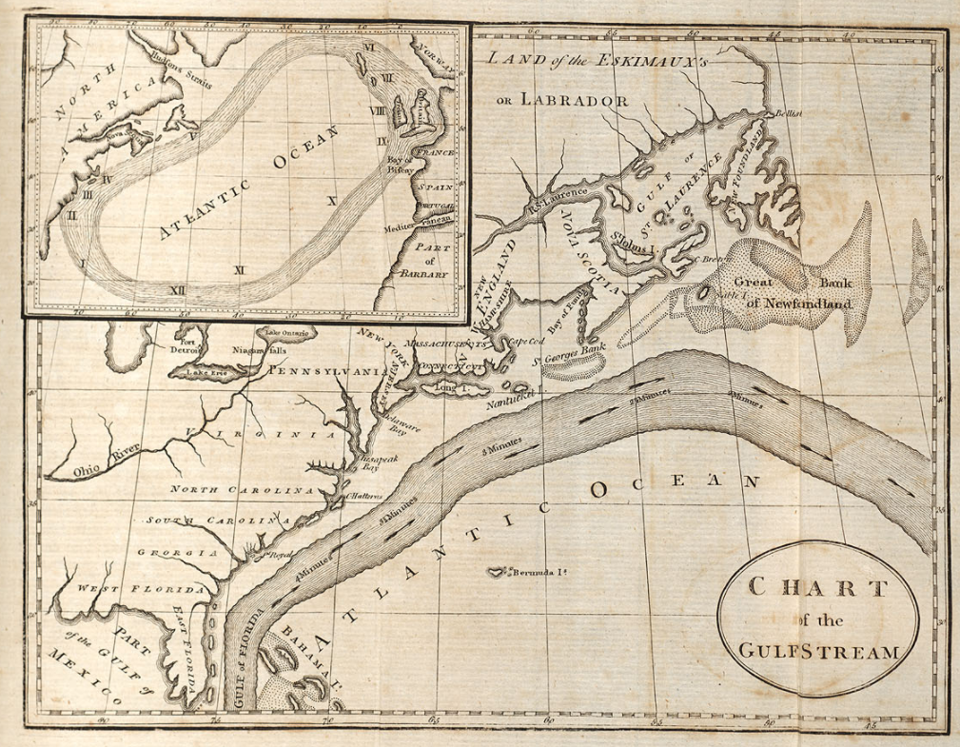 |
| Fig. 1 Drawing of Gulf Stream (1769) |
All scientific papers are questionable because proper questioning is fundamental to science.
Questioning the unquestionable or not questioning the questionable, however, are not proper practices.
By "the unquestionable" I mean assertions such as "gravity exists", "the Earth is not flat", "the Earth is orbiting the Sun", or "most scientists confirm that global warming is taking place", and that in the here and now "ice sheets are melting so as to cause sea level to both rise and fall."
By "the questionable" I mean the many assertions of fossil fuel companies and their paid-for scientists to the contrary (Merchants of Doubt, Smoke & Fumes) for which they are being sued and investigated (Oilfluenza, Affluenza, and Disgorgement - 2, New York Attorney General Investigating ExxonMobil).
But more than that, I mean scientific papers concerning those issues that are not properly questioned.
So, today I question: Valle-Levinson, A., A. Dutton, and J. B. Martin (2017), Spatial and temporal variability of sea level rise hot spots over the eastern United States, Geophys. Res. Lett., 44, doi:10.1002/2017GL073926.
II. Questionable Issues In Today's Questionable Paper
That paper attempts to show that inordinate sea level change along the East Coast is due to dynamics other than the primary cause: ice sheet melt.
The fundamental problem with the paper's assertion stems from the reality that to derive a long term understanding of why sea level change varies along the East and West Coasts of the U.S., one must understand the major cause of it, not a or the minor cause of it.
III. Key Points
The paper sets forth:
"Key Points ... The North Atlantic Oscillation determines the latitudinal position of hot spots, while ENSO is related to their timing" and "Local or regional rates of SLR may exceed the global mean because of a suite of factors related to ocean-atmosphere interactions (e.g., wind and current strength) or static equilibrium processes, e.g., melting land ice ..."(AGU Publications, p. 1, PDF). They do not indicate which dynamics ("North Atlantic Oscillation" ... "wind and current strength" ... "static equilibrium processes") are major factors or which are minor factors.
IV. They Have A Point
However, they do make a sizable point:
"The decline of the AMOC has previously gained the most traction as an explanation for the past acceleration of SLR north of Cape Hatteras, in part, because it is a consistent feature in ocean dynamic modeling of the evolution of regional sea level change patterns in the context of global warming ... [however] the argument cannot explain the recent shift in the rates of regional SLR that we have documented south of Cape Hatteras."(ibid, emphasis added). In other words, they point out that their hypothesis as to causes is limited to south of Cape Hatteras, and it is contrary to what takes place north of Cape Hatteras.
That is a good point, however, it also falsifies their hypothesis.
That is not so bad in that it means that their hypothesis is a scientific hypothesis, because it can be falsified (a hypothesis that can't be proven, or to the contrary falsified, is not a scientific hypothesis).
V. The Fatal Flaw In Their Myopic View
The graphic at Fig. 1 shows that Atlantic currents have been around since the Industrial Revolution began circa 1750.
The records of tide gauge stations along the East Coast and West Coast show that sea level change was not significant at that time.
But it has both decreased and increased steadily since.
At times the decrease and increase have accelerated, depending on the distance from ice sheets and glaciers (Proof of Concept , 2, 3, 4, 5, 6, 7, 8).
The featured wind and ocean currents mentioned in their paper were not impacted as the ice sheets have been, and therefore cannot be a serious historical source of major sea level change along the East Coast.
VI. Conclusion
The authors did not mention the word "gravity" or the phrase "sea level fingerprints" in their paper.
Those issues are prominent in the current understanding which the consensus of oceanographers and sea level change scientists currently set forth as major players in the sometimes perplexing dynamics of sea level change.
They need to check it out (The Ghost-Water Constant, 2, 3, 4, 5, 6, 7, 8, 9; The Gravity of Sea Level Change, 2, 3, 4).
The ice sheets have been melting for far longer than previously thought (Antarctica 2.0, 2).
And it is much more serious than wind and currents south of Cape Hatteras:
- The Extinction of Charleston
- The Extinction of Philadelphia
- The Extinction of Washington, D.C.
- The Extinction of Boston
- The Extinction of Miami
- The Extinction of Manzanillo
- The Extinction of Houston
- The Extinction of Providence
- The Extinction of Chesapeake Bay Islands
The next post in this series is here, the previous post in this series is here.
Those authors are myopic, in the sense that they are missing the forest for the trees.
ReplyDelete